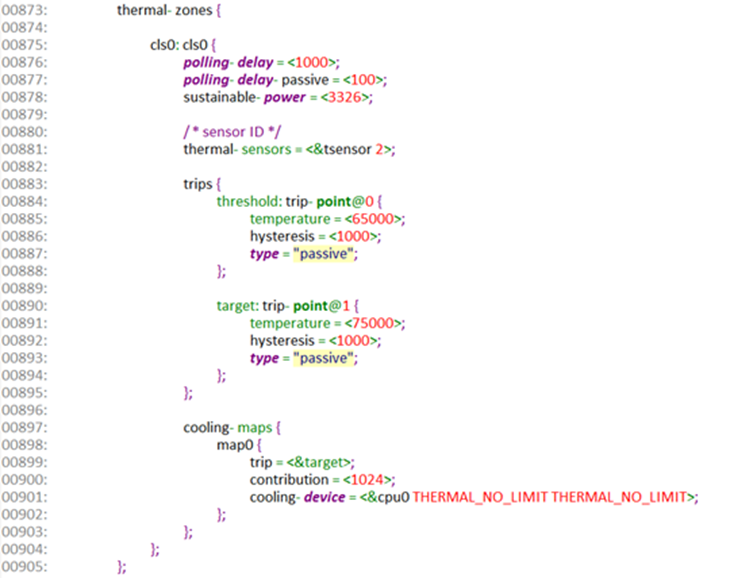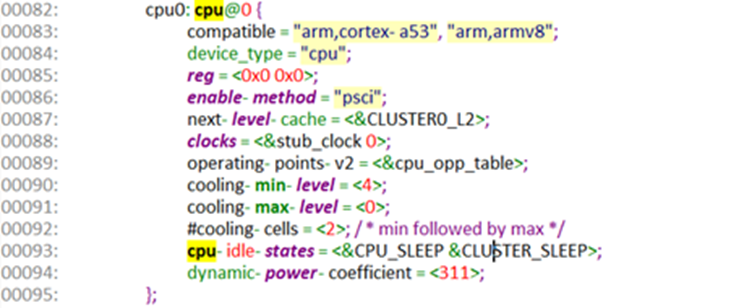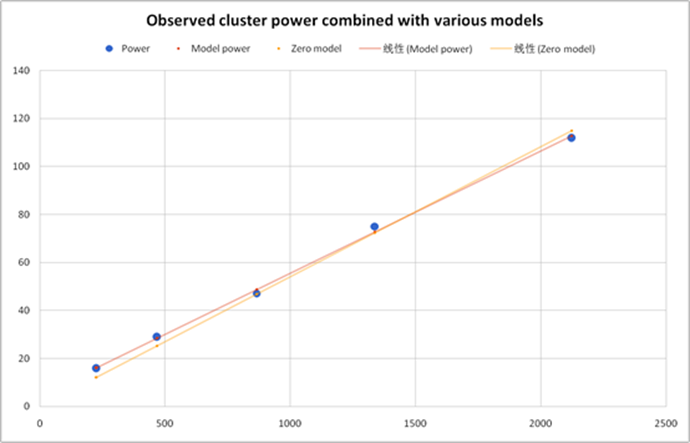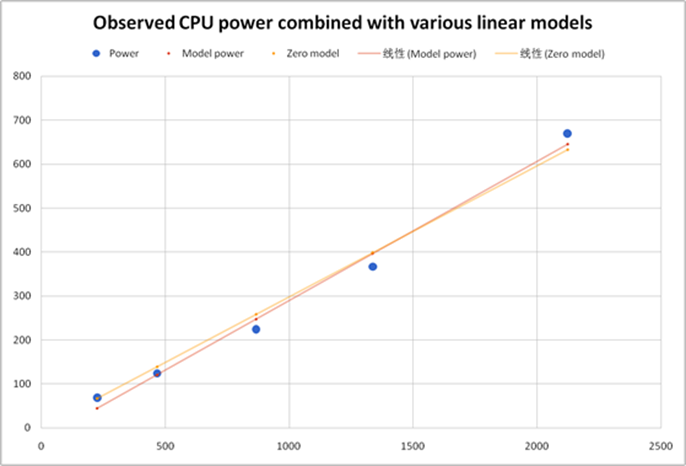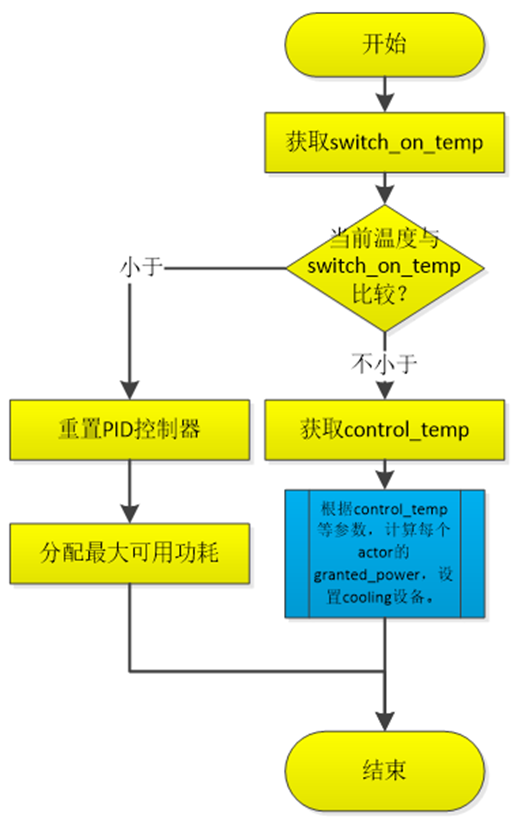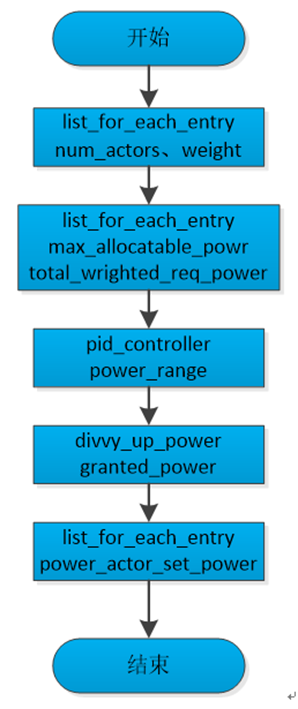Android/Linux Thermal Governor之IPA分析与使用
IPA(Intelligent Power Allocator)模型的核心是利用PID控制器,Thermal Zone的温度作为输入,可分配功耗值作为输出,调节Allocator的频率和电压值。
由Power Management一般开发模型可知,包括模型建立,模型实现,验证。
1 IPA模型
PID控制器在Sustainable Power基础上,根据当前温度和Control Temp之间的差值,来调节可分配功耗值的大小,进而调节Cooling设备的状态,也即调整OPP(Voltage和Frequency组合)。
所谓Sustainable Power是在不同OPP情境下,某一个最大OPP的温度保持基本稳定。比其大者,温度上升明显;比其小者温度保持不变或者下降。这可以通过监测不同OPP对应的温度值,得到一个Sustainable Power。
另一个就是根据当前环境预估下一个场景功耗值。一般认为包括两部分Dynamic Power和Static Leakage,这是由实测过程中得出的经验。Dynamic Power可以认为跟Voltage和Frequency相关;Static Leakage跟Voltage和Temperature有关。根据实测得到的数据,进行分析得到最吻合数据的一组算式。由于的HiKey实测中,Static Leakage比较小,就被忽略了。所以最终Power值就只跟Voltage和Frequency相关,据此就可以算出OPP对应的功耗值。OPP和功耗之间就建立了联系。
在一个重要参数就是PID控制器的参数P、I、D的确定,这部分也存在一定的经验值。需要测试几组不同参数,然后看温度控制效果。
2 IPA测试环境
1. 在最靠近CPU的地方引出测试点。
2. 接出Ground、V+、V-到ARM Energy Probe。
3. 通过软件设置特殊状态:
1. 对于sustainable power需要将8核跑在100%workload。
2. 对于测试Cluster Power和CPU Power就比较复杂,下面单列。
4. 使用Ipython脚本读取Thermal Zone温度和测试点功耗。
HiKey对应的Cluster和CPU功耗状态如下:
|
Power State |
PD_CPUx/CLKIN |
PDCORTEXA53 |
PD_L2 |
LinuxKernel |
|
|
CPU |
CPU P-State |
On |
On |
On |
P-State |
|
WFI |
On, internal clock gating |
On |
On |
C-State |
|
|
CPU Off |
Off |
On |
On |
C-State |
|
|
Cluster |
Cluster P-State |
On or Off |
On |
On |
P-State |
|
Cluster L2 Retention |
Off |
Off |
Retention |
C-State |
|
|
Cluster Off |
Off |
Off |
Off |
C-State |
3 IPA重要参数
sustainable-power
|
OPP(MHz) |
Sustainable power |
|
729 |
2155 |
|
960 |
3326 |
|
1200 |
5285 |
sustainable-power在thermal-zone里面,是因为测量的温度是基于thermal-sensors的,然后每个thermal-zone包含若干trips和cooling-maps。
通过观察温度,在729MHz的时候温度不会增加,在960MHz的时候温度缓慢增加,在1200MHz的时候温度增加很快。所以确定sustainable-power在960MHz。
在Thermal框架中有一个work queue会去轮询thermal_zone_device_check,根据Trip类型不同会执行不同的delay,passive模式100ms,其他1000ms。
control_temp
IPA模型有两个温度参数很重要,当温度低于65C的时候IPA处于关闭模式,reset PID控制器。当温度高于65C,IPA开始起作用;75C是IPA的control_temp,也即高于75C,IPA就会考虑降低可分配功耗,以达到降低温度的目的。
对于cooling-maps,需要上下两张图结合理解。trip表示在target开始启动cooling;contribution是针对对个Allocator进行权重分配;cooling-device参数是<设备 min max>。这里面设置的min和max需要在cooling-min-level和cooling-max-level之间。cpufreq会将对应值转换成OPP对应的voltage和frequency进行设置。
dynamic-power-coefficient
echo 0 > /sys/devices/system/cpu/cpu[1…7]/online,关闭CPU1-CPU7,只保留CPU0。
echo mem > /sys/power/state,通过对内核代码hack使SoC相对于CPU0工作状态,逐渐关闭CPU0,Cluster0,整个SoC。得到如下数据:
|
OPP(MHz) |
Voltage(V) |
Cluster Power Off State (mW) |
Cluster P-State (mW) |
Cluster Power (mW) |
CPU WFI (mW) |
CPU P-State (mW) |
CPU Dynamic Power(mW) |
|
208 |
1.04 |
344 |
360 |
16 |
379 |
429 |
69 |
|
432 |
1.04 |
345 |
374 |
29 |
387 |
498 |
124 |
|
729 |
1.09 |
346 |
393 |
47 |
408 |
617 |
224 |
|
960 |
1.18 |
352 |
427 |
75 |
442 |
794 |
367 |
|
1200 |
1.33 |
367 |
479 |
112 |
508 |
1149 |
670 |
功耗计算公式:
power = dyn_coeff * (freq * volt^2) + static_coeff * F(volt) * F(Temp)
Dynamic power = capacitance * (freq * volt^2)
|
Cluster model |
|||||
|
Freq |
Voltage |
F * V^2 |
Power |
Model power |
Zero model |
|
208 |
1.04 |
224.9728 |
16 |
16 |
12 |
|
432 |
1.04 |
467.2512 |
29 |
29 |
25 |
|
729 |
1.09 |
866.1249 |
47 |
49 |
47 |
|
960 |
1.18 |
1336.704 |
75 |
73 |
72 |
|
1200 |
1.33 |
2122.68 |
112 |
113 |
115 |
|
Gradient (capacitance) |
Intercept (staic power) |
||||
|
Linear regression |
0.051 |
4.716716513 |
|||
|
L.R. thru zero |
0.054 |
0 |
|
CPU model |
|||||
|
Freq |
Voltage |
F * V^2 |
Power |
Model power |
Zero model |
|
208 |
1.04 |
224.9728 |
69 |
44 |
67 |
|
432 |
1.04 |
467.2512 |
124 |
121 |
139 |
|
729 |
1.09 |
866.1249 |
224 |
247 |
258 |
|
960 |
1.18 |
1336.704 |
367 |
396 |
399 |
|
1200 |
1.33 |
2122.68 |
670 |
645 |
633 |
|
Gradient (capacitance) |
Intercept (staic power) |
||||
|
Linear regression |
0.317 |
-27.12625497 |
|||
|
L.R. thru zero |
0.298 |
0 |
由以上Cluster和CPU的coefficient得到,dynamic-power-coefficient = (0.298 + (0.054/4 CPUs)) * 1000 = 311。
LINEST:使用最小二乘法对已知数据进行最佳直线拟合,然后返回描述此直线的数组。
|
LINEST(known_y's,known_x's,const,stats) Known_y's 是关系表达式 y = mx + b 中已知的 y 值集合。 如果数组 known_y's 在单独一列中,则 known_x's 的每一列被视为一个独立的变量。 如果数组 known_y's 在单独一行中,则 known_x's 的每一行被视为一个独立的变量。 Known_x's 是关系表达式 y = mx + b 中已知的可选 x 值集合。 数组 known_x's 可以包含一组或多组变量。如果仅使用一个变量,那么只要 known_x's 和 known_y's 具有相同的维数,则它们可以是任何形状的区域。如果用到多个变量,则 known_y's 必须为向量(即必须为一行或一列)。 如果省略 known_x's,则假设该数组为 {1,2,3,...},其大小与 known_y's 相同。 Const 为一逻辑值,用于指定是否将常量 b 强制设为 0。 如果 const 为 TRUE 或省略,b 将按正常计算。 如果 const 为 FALSE,b 将被设为 0,并同时调整 m 值使 y = mx。 Stats 为一逻辑值,指定是否返回附加回归统计值。 如果 stats 为 TRUE,则 LINEST 函数返回附加回归统计值,这时返回的数组为 {mn,mn-1,...,m1,b;sen,sen-1,...,se1,seb;r2,sey;F,df;ssreg,ssresid}。 如果 stats 为 FALSE 或省略,LINEST 函数只返 |
4 IPA实现
|
static struct thermal_governor thermal_gov_power_allocator = { .name = "power_allocator", .bind_to_tz = power_allocator_bind, .unbind_from_tz = power_allocator_unbind, .throttle = power_allocator_throttle, }; |
|
static int power_allocator_bind(struct thermal_zone_device *tz) |
Power Allocator的结构体,包括三个核心函数power_allocator_bind、power_allocator_unbind、power_allocator_throttle。
初始化PID控制器的参数并且将power_allocator_params绑定到tz->governor_data。
|
struct power_allocator_params { bool allocated_tzp; s64 err_integral; //accumulated error in the PID controller s32 prev_err; //error in the previous iteration of the PID controller int trip_switch_on; //first passive trip point of the thermal zone. The governor switches on when this trip point is crossed. int trip_max_desired_temperature; //last passive trip point of the thermal zone. The temperature we are controlling for. }; |
PID参数
|
if (!tz->tzp->k_po || force) tz->tzp->k_po = int_to_frac(sustainable_power) / temperature_threshold; if (!tz->tzp->k_pu || force) tz->tzp->k_pu = int_to_frac(2 * sustainable_power) / temperature_threshold; if (!tz->tzp->k_i || force) tz->tzp->k_i = int_to_frac(10) / 1000; |
从DTS获得的参数可知,temperature_threshold = control_temp - switch_on_temp = 75000-65000 = 10000。
tz->tzp->k_po = int_to_frac(sustainable_power) /temperature_threshold =3326*1024/10000=340.5824
tz->tzp->k_pu = int_to_frac(2 * sustainable_power) /temperature_threshold =3326*2*1024/10000=681.1648
tz->tzp->k_i = int_to_frac(10) / 1000 = 10*1024/1000=10.24
另两个参数tz->tzp->k_d、tz->tzp->integral_cutoff默认为0。
PID控制器
图表 9 power_allocator_throttle流程
power_allocator_throttle作为IPA的调节功能,首先判断当前温度是否小于switch_on_temp。如果小于的话,就不进入PID调节,分配最大可用功耗。反之,则使用PID进行功耗分配。当PID调节一段时间后,如果温度低于switch_on_temp时,PID控制器的所有参数也会被重启,所以PID控制器也会得到纠正。
allocate_power作为IPA的核心,遍历所有thermal_instances,获得actor数目及其权重;然后计算每个actor的max_power、weighted_req_power和所有actor的max_allocatable_power、total_weighted_req_power。
pid_controller根据control_temp、max_allocatable_power即pid参数计算出power_range作为下一次分配的功耗预算。
divvy_up_power基于weighted_req_power、max_power、num_actors、total_weighted_req_power、power_range在每个actor之间分配可用功耗,得出granted_power。
power_actor_set_power根据分配到的功耗设置cooling设备。cdev->ops->power2state将功耗值转换成cooling设备状态值,thermal_cdev_update的cdev->ops->set_cur_state对cooling进行设置。至此完成整个Thermal Zone的调节。
有几个重要的概念,thermal_instance指的是特定thermal_zone中特定trip上的cooling设备;power actor是一个功耗消耗实体,并且可进行功耗状态转换,能通过调节状态达到调节功耗的目的;actor的权重,默认是1024,如果比较重要可以增加weight值,反之可以减小。功耗分配不是基于req_power而是weighted_req_power。
IPA的缺陷:PID控制器在周期性tick环境下效果比较好,如果不规则重复则可能表现不太好,比如中断触发。

